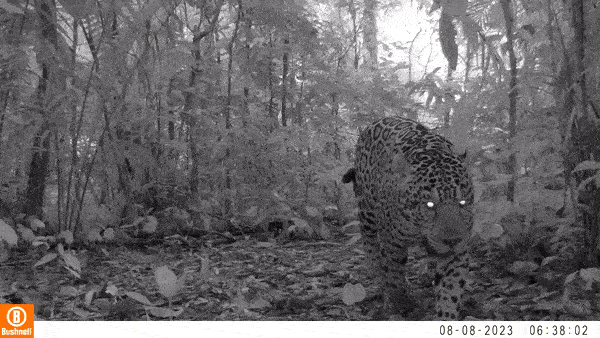Biodiversity credits, hactivists, and Indigenous groups
We’re hacktivists from two civilizations. Our code disintermediates climate markets for indigenous groups, based on their traditional hacks for jungle.
We need to innovate in climate and indigenous groups have underutilized solutions, but we’ve been ignoring them. So it’s time to change.
There is a reason a jaguar is the sexiest thing in the Amazon. Indigenous groups have been stewarding this ecosystem longer than civilization itself. They know, as our scientists do, that apex predators are the best metric for this healthy forest.
So how do we use this knowledge to better climate markets? Read more to find out…
Game camera video used in biodiversity crediting. By Jhony Lopez, leader of Savimbo’s biodiversity credit program.
“Look deep, deep into nature, and then you will understand everything better”
It’s not rocket science. Our civilization has perfected extraction. Other civilizations have perfected conservation. For conservation efforts to be effective, we need to learn from the pros.
We have to rapidly evolve climate markets for greater impact. Indigenous knowledge is an undercapitalized resource for measuring ecosystems. However, indigenous peoples have been poorly included in climate markets. Therefore emerging automation should utilize their knowledge while automating for scale.
Our biodiversity credit methodology is a computer algorithm for bottom-up conservation. It stops deforestation in the borderlands of pristine Amazon jungle because it’s an expression of indigenous thinking about that same healthy jungle.
What do locals know that you don’t about conservation?
Biodiversity science lags indigenous knowledge.
We’d love to think that Western science solves all problems. But we still lack viable market solutions for deforestation or ecosystem tracking. However, our hubris isn’t the whole story. The reality is Western science hasn’t devoted enough time, funding, or effort to tracking healthy ecosystems and other species. We need to learn from civilizations that have.
Indigenous people have known the solution for millennia. Their totemic animals are intricately entwined with ecology, culture, language, and conservation activities. Because they didn’t do it for science; they stewarded natural resources for survival.
Biodiversity is a better metric of natural ecosystem health than carbon credits. The presence of rare or endangered animals demonstrates intact water, soil health, below-canopy forest integrity, absence of noise pollution, and controlled human predation and trafficking. (Those ever-classy ecological co-benefits we’re trying so hard to quantify.) In the case of an animal like an apex predator, an indicator species is also indicative of the presence of the entire food chain.
But how do we quantify biodiversity? The truth is we’re really not great at quantifying other species. Species richness scores are poorly researched in many of the most biodiverse and remote zones of the world. Species themselves are ever-evolving and poorly classified. In the Catologue of Life, “The most complete authoritative list of the world's species - maintained by hundreds of global taxonomists,” we see the succinct tongue-in-cheek caveat “Be aware that the COL Checklist is still incomplete and undoubtedly contains errors.”
Yeah, we’re really cute, but we’re still getting there when it comes to being a caretaker species. (Don’t worry we’re not going to beat ourselves up today, we’re going to celebrate a cross-cultural victory!)
Wait! What about our indigenous friends?
Thus far, our efforts to create metrics that quantify biodiversity in all situations are earnest but difficult to standardize. Now finally, biodiversity is easier to measure than carbon. How did we hack it? The solution, as always, was to ask the locals!
The biodiversity credit market has been delayed by difficulties with quantification and MRV (measurement, reporting, and verification). Buyers didn’t trust it because the metrics weren’t consistent.
The early design of biodiversity credits was based on the Walawacea protols. They utilized baskets of metrics that were defined at the project level. Projections that were then met, or not met. Sound familiar? Yep, its basically a multidimensional REDD+ project with all its pitfalls (counterfactual, project-defined baselines) only in five dimensions without any standardization of aims. No way a market still reeling from REDD+ failures will accept it.
The truth is, there is absolutely no way to be good at everything. We have to combine efforts. So after I tried to put a QR code on every tree in the jungle (yeah 😳, true story, fail fast!) Jhony and Fernando listened nicely, then kindly pointed out some really cool video clips of jaguars.
To my surprise, I learned that there is a 5,000-year history of using the jaguar to indicate a healthy jungle. In fact, Jhony tracked jaguars for fun (and occasionally for money when conservation nonprofits came around asking him where they were). Being the entrepreneur I am, I immediately put it into code, and being the hacktivist I am, I immediately open-sourced that code.
Savimbo biodiversity crediting algorithm where one second equals one month and blue circles are credited areas over time. Video by Enrique Balp data scientist.
Our code and the methodology to use it miraculously solve standardization problems. It works in every ecosystem, every species, every biodiversity hotspot, and every indigenous group automatically understands it. Because it’s based on a fundamental principle of how life lives on earth.
It’s based on indigenous knowledge.
Indicator species, why they work, and who they work for
The reason this code works to measure biodiversity is that it doesn’t measure everything. It measures what matters for conservation.
Take a scientific critique.
An eager scientist wrote me directly last week. He suggested a method that had led to the publication of two books in his name. Research ~500 wildlife species, determine a modern range map for each, then get 600 people to help identify habitat relationships with 33 habitat classifications. That should cover about two US states. To quote “Indicator species do not represent a fuller list or richness within a system nor the functions performed within that system. This is a simple approach that may not represent its true credit value. Everything small and large counts!”
Of course, none of this work has been done in the Amazon, which covers 2.5 million square miles and has at least 3,680 unidentified tree species alone. In our region, former FARC territory, and one of the most biodiverse in the world, it has 16% deforestation rates in some areas due to narcotrafficking, and hasn’t had a Western scientist in here for 20 years. No worries, 600 Western scientists and several books later we… won’t have any jungle left to measure.
The Amazon is at a tipping point folks. We’re out of time for perfect methods.
We need a quick, dirty, fast, fair method that directly incentivizes locals, the agents of change in deep jungle. Giving them the power to move the dial in the right direction, on their terms, and with their knowledge.
We need the algorithm above. One indicator species like an apex predator, is captured on video camera (an inexpensive alternative to animal tagging or soundscapes). Credits are paid within the living range of that species, on a reasonable timeline that fits with smallfarmer and indigenous hunter-gatherer behavior. An imperfect estimate of intact forests, and intact biodiversity that works for locals battling to preserve a complex, now chaotic system.
This method is cost-effective and well... EFFECTIVE. It stops deforestation immediately on the borders of primary jungle and extraction economies. At $30/ha/yr, it also costs 70% less than carbon credits for the same outcome (an estimated $100/ha/yr).
Let’s stop trying for perfection, and start aiming for impact.
In conclusion
We need hacktivists from two cultures to figure out how to swing the climate steering wheel in time to avoid a catastrophic global collapse. We don’t have time for perfect methods if they were even possible in a complex, chaotic system.
Written by Drea Burbank, MD and Robert Senter. Drea is a MD-technologist and co-founder of Savimbo. Robert is a Polymath at Savimbo who enjoys writing.


